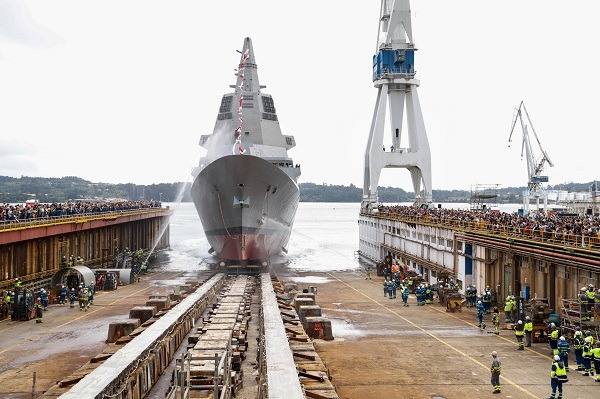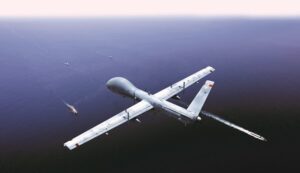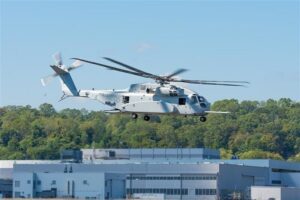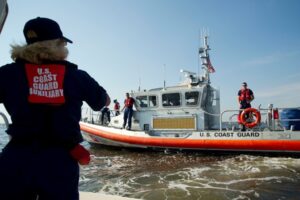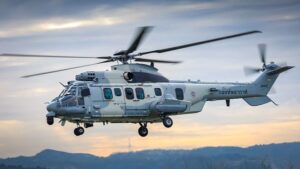From this point forward, construction will continue at the shipyard’s dock until delivery in 2028
Navantia held on September 11 the launching ceremony of the F111 “Bonifaz” frigate, the first unit of the F-110 programme for the Spanish Navy, in a highly symbolic event in Ferrol (A Coruña).
The ceremony was attended by the president of the Spanish Government, Pedro Sánchez, and by Her Majesty Queen Sofía who, as the ship’s sponsor, ceremonially broke a bottle against the hull moments before the frigate slid down the slipway into the estuary.
The event was attended by civil and military authorities, including the Chief of the Defence Staff Admiral Teodoro López Calderón, the Chief of Staff of the Navy, Admiral Antonio Piñeiro and Navantia’s Chairman Ricardo Domínguez.
Around 5,000 people gathered at the shipyard’s grandstand, mostly Navantia employees and their families, along with staff from partner companies. The frigate was launched into the sea after receiving its ceremonial ‘baptism’ with a bottle of Albariño wine, accompanied by the Spanish national anthem performed by the Northern Tercio Music Unit. The vessel was blessed by Chaplain Vicente Hernández Chumillas, Director of Religious Affairs for the Navy.
Named in honour of Ramón Bonifaz, the first Admiral of Castile, the F111 was launched one month ahead of schedule, with a progress of over 70%. Prior to the ceremony, Defence Minister Margarita Robles visited the shipyard to sign the formal acceptance of the vessel’s launch.
From this point forward, construction will continue at the shipyard’s dock until delivery in 2028. Three of the five frigates in the series are currently under construction in Ferrol, with four blocks of the F112 already on the slipway following its keel-laying milestone in April 2025. The remaining blocks of the F112 and nine blocks of the F113 are being built in the workshops.
Strategic autonomy and growth
The F110 programme marks a major step forward for the Spanish Navy and for the industrial and technological development of Navantia and its partners. It strengthens Spain’s strategic autonomy, boosts exports, and is expected to generate around 9,000 jobs over more than a decade, involving 500 companies nationwide.
Pedro Sánchez, President of the Spanish Government, stated: “This event not only marks a new chapter in our Navy’s history, but is also a hugely important day for Navantia and the Spanish naval industry. Above all, it is a historic day for Ferrol and for all of Galicia. This 11th of September opens a new era of hope for Ferrol, with reindustrialisation leading the way.”
Admiral Antonio Piñeiro, Chief of Staff of the Spanish Navy, added: “The frigate Bonifaz is not merely a new vessel; it embodies Spain’s commitment to innovation and technological sovereignty. This ship will provide a decisive strategic and deterrent advantage, and in line with our Armada 2050 vision, it reflects our firm intent to anticipate future challenges.”
In his speech, Navantia President Ricardo Domínguez thanked all workers for their dedication and effort in delivering a programme that, “with innovations such as the digital twin, integrated services system, and cutting-edge sensors, antennas and radars, is a symbol of Spanish innovation. We are confident it will be an international success, just as the worldly recognised F100 frigates were”.
Eduardo Dobarro, Navantia’s Director of Frigates and Intervention Ships, remarked: “This achievement reflects solid planning, exemplary institutional collaboration with the Ministry of Defence and the Navy, and above all, the tireless work of those who made it possible.”
Defence capabilities
Approved in 2019, these escort vessels feature anti-air, anti-surface, and anti-submarine capabilities, and are designed to operate jointly with other units and support maritime security missions alongside civil authorities.
Navantia will deliver one of the most digital and automated ships to the Navy, equipped with a digital twin and a sensor network (Integrated Services System) that enables data-driven decision-making. These ships are safer, can operate with reduced crews, and are capable of integrating unmanned vehicles.
Developments include Navantia’s own SCOMBA combat system, the Integrated Platform Control System (IPMS), and engines and systems manufactured at Navantia’s facilities in Bahía de Cádiz and Cartagena.
The digital twin is a virtual replica of the ship, developed in collaboration with the Navy and the Directorate General for Armament and Materiel. Powered by sensors and technologies such as IoT, cloud computing, and machine learning, it enhances data-driven decision-making and supports operational and maintenance evolution.
This virtual model is optimised by the Integrated Services System (ISS), a neural network with sensors embedded in the ship’s lighting infrastructure, developed with the Navy and the University of Vigo, fostering an innovation ecosystem around the programme.
The frigate features the SCOMBA combat system (developed by Navantia’s Systems division), acting as the ship’s “brain”, capable of processing sensor, radar, and weapon data in real time. Among its innovations is the integrated mast, located on the superstructure, which optimises electromagnetic spectrum use and reduces radar signature.

